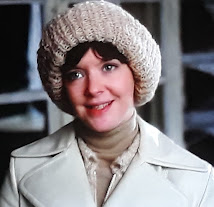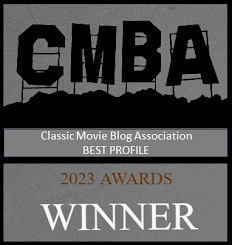
We thought October was the perfect month to unveil our choices for the 25 Greatest Classic Horror Films. Note that these are "classic" horror films, which means they must have withstood the test of time. Thus, you won't find any movies made after 1980. You also won't find any science fiction films, though sometimes the horror and sci-fi genres seem to overlap. But, on the basis they were more sci-fi than horror, we omitted some fine pictures like
Invasion of the Body Snatchers, both versions of
The Thing,
Quatermass and the Pit. In compiling our list, we considered historical significance, influence, and fright factor for each film. Some well-known horror movies didn't make the grade. Frankly, we have never been impressed with
The Texas Chainsaw Massacre,
Friday the 13th, or even
Kwaidan.
1.
Curse of the Demon (Night of the Demon) (1958) - If Hitchcock had made a straight horror film, I think it would have turned out like this one-of-a-kind chiller about a villain that conjures up a rather hideous demon to dispose of those who oppose him. Niall McGinnis shines as the kind of Hitchcock bad guy that lovingly cares for his mother and hosts a Halloween party for the kiddies.
 |
| Kyra Schon in Night of the Living Dead. |
2.
Night of the Living Dead (1968) - Long before The Walking Dead TV series, George Romero made flesh-eating ghouls fashionable with this drive-in classic. It's funny, scary, gory, and grim (especially the ending, which has caused some critics to label it a Vietnam War analogy).
3.
Brides of Dracula (1960) - No Dracula and no Christopher Lee? No problem--as those constraints inspired Hammer to reach new heights with an intelligent vampire tale filled with fine performances, an imaginative plot, and the best ending of any vampire movie.
4.
The Last Man on Earth (1964) - Writer Richard Matheson didn't care for this Italian-made adaptation of his popular novel
I Am Legend, in which a plague of vampirism wipes out most of the Earth's population. I think it's an inventive, effective chiller with a strong Vincent Price performance.
 |
| Margaret Johnson in Burn, Witch, Burn. |
5.
Burn, Witch, Burn (Night of the Eagle) (1962) - An amateur witch tries to further her husband's academic career, but runs afoul of someone else practicing the black arts. I'm flummoxed as to why this smart look at believers vs. skeptics isn't better known.
6.
The Leopard Man (1943) - Director William Friedkin (
The Exorcist) dubbed its most famous scene "one of the greatest horror sequences ever filmed." I agree. But this Lewton-produced mystery, set in New Mexico, also boasts several other tension-filled set pieces (especially the cemetery murder).
7.
Halloween (1978) - This ultimate slasher film is a remarkably well-crafted picture from director John Carpenter. His use of the widescreen frame is a virtual textbook on creating suspense using nothing but space.
 |
| Sharon Tate as Sarah. |
8.
The Fearless Vampire Killers (1967)- Roman Polanski's parody of vampire films is so good that it stands on its own as a first-rate horror picture. Polanski displays an uncanny understanding of the genre, from the snowy setting to the famous dance of the vampires (the film's original title). Sharon Tate exudes charm as the heroine, proving she was more than just a pretty face.
 |
| The famous pool scene in Cat People. |
9.
Cat People (1942) - With the first of his RKO films, producer Val Lewton proved that the horror in our imaginations is far more frightening than what any filmmaker can show us. It also boasted rich psychological undercurrents with its themes of sexual repression and jealousy.
10.
Nosferatu (1922) - F.W. Murnau's silent vampire classic still chills today thanks to the director's haunting visuals and Max Schreck's memorable Count Orlok. It's the first horror screen classic.
 |
| A shadow scene from The 7th Victim. |
11.
The 7th Victim (1943) - Val Lewton's eerie tale of devil worshippers in Greenwich Village predates the better-known--but far less effective--
Rosemary's Baby by three decades. Mark Robson's use of dark shadows gives the film a noirish feel.
12.
The Innocents (1961) - The best of the horror films in which the supernatural elements may be real or (more likely in this case) imagined. Deborah Kerr gives a tour de force performance as the unhinged governess and Martin Stephens matches her in possibly the best child performance of the 1960s. Superior in every way to
The Haunting.
 |
| Elsa Lanchester as the unwilling bride. |
13.
Bride of Frankenstein (1935) - James Whale's masterpiece is generally considered the finest Universal horror film (though personally, I'm quite fond of
Son of Frankenstein). Thematically rich,
Bride gives the Monster a voice and Karloff the opportunity to make the creature all too human.
14.
Frankenstein Must Be Destroyed (1969) -Hammer's best Frankenstein movie is a potent portrayal of obsession for the sake of science. Peter Cushing is excellent as the driven doctor, but Freddie Jones matches him as the sympathetic "monster."
15.
Horror of Dracula (
Dracula) (1958) - Along with
The Curse of Frankenstein, this vampire classic established Hammer Films and reinvigorated the horror genre for a whole new generation. It also transformed Van Helsing into an action hero, presented a new Dracula that inspired genuine fear, and made genre stars of Peter Cushing and Christopher Lee.
 |
| Chris Lee in The Devil Rides Out. |
16.
The Devil Rides Out (The Devil's Bride) (1968)- Christopher Lee portrays the hero in this lively tale, set in 1929, about an aristocrat that heads a cult of devil worshippers. Charles Gray makes a formidable villain and his appearance in a car's rearview mirror is genuinely creepy. Ditto for a daring rescue during one of the cult's ceremonies.
17.
The Uninvited (1944) - This well-made ghostly tale remains unique for two reasons. It was a mainstream Hollywood film with a big-name star (Ray Milland) at a time when horror movies were "B" fare. It also featured actual ghosts--unlike later films where the lines of reality become blurred (e.g.,
The Innocents,
The Haunting).
 |
| Bernie Casey as the head gargoyle. |
18.
Gargoyles (1972) - For many years, I felt as if I was the only person who truly appreciated this unique made-for-TV terror tale set in the Southwestern U.S. However, a 2011 DVD release and a recent showing at an Austin, Texas, "drafthouse cinema" confirms that I am not alone!
19.
Black Sunday (1960)- Bathed in deep shadows and swirling fog, Mario Bava's black-and-white masterpiece made a genre star of Barbara Steele. She plays a witch who returns from the grave to wreak vengeance. (Note to self: Never remove a gold mask from a rotting corpse!)
 |
| Michael Redgrave in Dead of Night. |
20.
Dead of Night (1945) - The first great horror anthology is most famous for its clever and disturbing framing device. The individual tales are all good, but the one with Michael Redgrave's ventriloquist is chilling.
21.
Psycho (1960)- The shower scene and the staircase murder still pack a wallop, but it's Hitchcock's narrative structure that makes
Psycho so memorable. For many of us, it was the first film we saw where the (supposed) heroine was killed halfway through its running time.
22.
The Phantom of the Opera (1925) - The most famous film of the first horror superstar, Lon Chaney, Sr., is a must for this list. In addition to its historical significance,
Phantom offers two iconic scenes: the crashing of the crystal chandelier and the unmasking of Erik.
 |
| Rathbone in a publicity still. |
23.
Son of Frankenstein (1939) - With Bela Lugosi's Igor and Lionel Atwill's one-armed prefect, Universal created two of its most famous horror film characters. This unheralded classic has other virtues, too: Karloff's last appearance as the Monster, Basil Rathbone's manic performance, Jack Otterson's brilliant sets, and Frank Skinner's music.
24.
Phantasm (1979)- A youth, a tall undertaker, dwarf zombies, and a deadly flying sphere.... Phantasm doesn't always make sense, but if Luis Bunuel had fashioned a surrealistic horror film, I'd like to think it would have turned out to be something like this.
25.
Suspiria (1977) - I originally included Italian director Dario Argento's
Deep Red (
Profondo rosso) (1975) in this final slot, since it helped define the Giallo genre that grew out of Hitchcock's
Psycho and Michael Powell's
Peeping Tom. However, I bumped it in favor of Argento's supernatural classic about the world's most terrifying dance academy. In addition to Argento's trademark camera work, his use of color is breath-taking.
 |
| Red is the dominant palette in this scene from Suspiria. |
Honorable Mentions:
Captain Kronos: Vampire Hunter;
The Masque of the Red Death; Trilogy of Terror;
The Exorcist;
The Tingler; and
Dracula Has Risen from the Grave.

























































